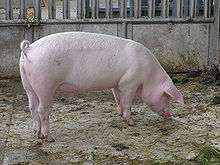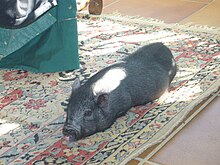Pig
| Pig Temporal range: Early Pleistocene to present
| |
|---|---|

| |
| A domestic pig on an organic farm in Switzerland | |
| Scientific classification | |
| Domain: | Eukaryota |
| Kingdom: | Animalia |
| Phylum: | Chordata |
| Class: | Mammalia |
| Order: | Artiodactyla |
| Family: | Suidae |
| Subfamily: | Suinae |
| Genus: | Sus Linnaeus, 1758 |
Pigs or domestic pigs are mammals in the genus Sus. Pigs are in the Suidae family of even-toed ungulates.
Related, but outside the genus, are the babirusa and the warthog. Pigs, like all suids, are native to the Old World. Baby pigs are called piglets or pups.[1] Pigs are omnivores and are very social and intelligent animals.[2] Its ancestor is the common Eurasian wild boar (Sus scrofa).

The pig has stout, barrel-shaped bodies, with short legs.

The flesh of domestic pigs is eaten as food and is called pork. The Jewish and Muslim religions, and some Christian denominations, believe eating pork is wrong. Pig farmers take care that the animals do not get diseases or parasites which might harm humans.

Domestic pigs come in different colours, shapes and sizes. They are usually pink, but little pigs kept as pets (pot-bellied pigs) are sometimes other colours. Pigs roll in mud to protect themselves from sunlight. Many people think that pigs are dirty and smell. In fact, they roll around in the mud to keep bugs and ticks away from their skin. This also helps to keep their skin moist and lower their body temperature on hot days. They are omnivores, which means that they eat both plants and animals.
Pigs are smart animals. They are even able to learn how to play video games.[4] Pigs are commonly used as working animals. They are used to hunt for truffles, pull carts and sniff out landmines.[4] Pig races exist.
Care[change | change source]
Pigs need a warm, clean area under a roof to sleep, and they should not be crowded. They need to be checked for sickness regularly. Pigs need lots of water. Over half their body weight is made up of water.[5] Pigs should be given all the feed they will eat, which is usually four to five pounds a day for adult pigs.[6] Corn is a good food for pigs, but they should also have protein supplements as well.
Pigs can be found throughout the world living on farms and in the wild, and they are also popular pets. Pigs are kept and slaughtered for their flesh, pork.

References[change | change source]
- ↑ "Piglet - Definition and More from the Free Merriam-Webster Dictionary". Merriam-webster.com. 31 August 2012. Retrieved 15 September 2013.
- ↑ Angier, Natalie (10 November 2009). "Pigs Prove to Be Smart, if Not Vain". The New York Times.
- ↑ "Peppa Pig | Official Site | Welcome to the grown ups site for Peppa Pig". Peppa Pig (en_US). Retrieved 2019-10-18.
- ↑ 4.0 4.1 https://www.telegraph.co.uk/culture/qi/8912210/QI-Quite-interesting-facts-about-pigs.html Archived 2012-10-24 at the Wayback Machine The Telegraph. Retrieved 05/12/2011.
- ↑ Pig Information. Retrieved 15 Mar 2011.
- ↑ Getting Started with Pigs Archived 2011-03-15 at the Wayback Machine. Retrieved 15 Mar 2011.
